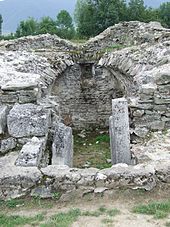Ulpia Traiana Sarmizegetusa
Coordinates: 45 ° 30 ′ 59.9 ″ N , 22 ° 47 ′ 12.6 ″ E
Ulpia Traiana Sarmizegetusa , full name Colonia Ulpia Traiana Augusta Dacica Sarmizegetusa , ( Greek Ζαρμιζεγέθουσα, Ζερμιζεγέθουσα ) was a Roman Colonia and capital of the Roman province of Dacia (Dacia) in the 2nd to 3rd centuries AD . The archaeological site is located in the area of today's Romanian municipality Sarmizegetusa in the Hunedoara district ( Transylvania ).
history
After the victory of the Roman Empire under Emperor Trajan in the second Dacian War in 105/106 AD and a short time after the destruction of the capital of the independent Dacian Empire, Sarmizegetusa Regia , the Romans built about 40 kilometers southwest of it between 108 and 110 AD a veterans' colony on the site of an army camp of the Legio V Macedonica . It was initially named Colonia Dacica and Trajan gave it the Ius Italicum . The settlement became the capital of the Roman province of Dacia. During Hadrian's reign , the name was changed to Colonia Ulpia Traiana Augusta Dacica Sarmizegetusa in order to reflect the symbolic power of the old Dacian capital, even if there was deliberately no settlement continuity between these cities.
As usual for a provincial capital, the city received a forum , a place of worship of the emperors (aedes Augustalium) and an amphitheater . The settlement was later raised to a municipality , during the reign of Severus Alexander (222–235) even referred to as a Metropolis . After the division of Dacia into several provinces, a governor resided here and convened the joint council of the "three Dacia" (concilium Daciarum trium) . Sarmizegetusa was the political, administrative and cultural center of Dacia, while the military and economic focus was more in the Castrum Apulum on the site of today's city of Alba Iulia .
After the withdrawal of the Roman troops and administration from Dacia in 271, Alans first settled here , whose empire was later taken over by Attilas Huns. During all this time, however, these areas were populated by parts of the Romanized Dacian population who had not left the province after the retreat of the Romans under Emperor Aurelian , in symbiotic coexistence with the immigrating peoples. After various tribes broke away here during the migration period, the (proto-) Bulgarians and finally various Turkic tribes conquered the region. It remains to be seen whether the Bulgarians advanced to Ulpia Trajana Sarmisegetuza, which is located in the mid-west of the province of Dacia, and the western movement of the Turkish tribes only began after the liberation of Jerusalem at the end of the 13th century. At this point the formation of the first Romanian voivodeship south of the Carpathian Mountains began.
Excavation site
Archaeological excavations have opened up the city of Colonia Ulpia Traiana Augusta Dacica Sarmizegetusa as a planned settlement according to tried and tested Roman plans. The heavily fortified place had an estimated 20,000 to 25,000 residents on about 30 hectares.
Individual evidence
- ↑ Cf. Ptolemy 3,8,9: Ζαρμιζεγέθουσα; Cassius Dio 68,8,7: Ζερμιζεγέθουσα ; Digest 50,15,1,9: Zarmizegetusa; Geographer of Ravenna 4,7: Sarmazege ; Tabula Peutingeriana 7.5: Sarmatian ; in inscriptions mostly with S.
- ^ Konrad Gündisch: "Capitals" in Transylvania. In Harald Heppner: capitals between the Save, Bosporus and Dnieper. Böhlau Verlag, Vienna / Cologne / Weimar 1998, pp. 51–83, on p. 53.
- ^ Konrad Gündisch: "Capitals" in Transylvania. In Harald Heppner: capitals between the Save, Bosporus and Dnieper. Böhlau Verlag, Vienna / Cologne / Weimar 1998, pp. 51–83, on p. 54.




